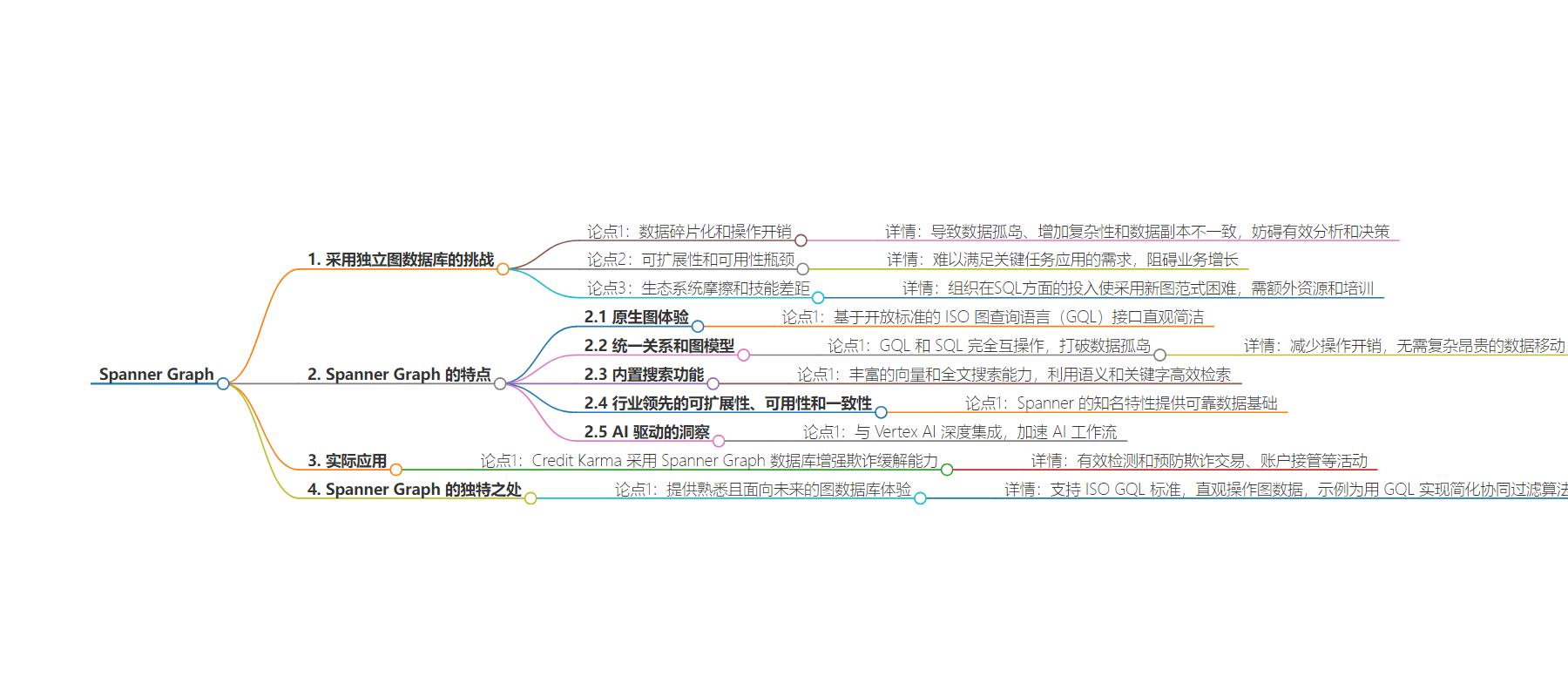包阅导读总结
1.
关键词:Spanner Graph、数据管理、挑战、独特优势、应用案例
2.
总结:文章介绍采用独立图数据库存在诸多挑战,Spanner Graph 重新构想图数据管理,具有统一数据库及多种能力,包括原生图体验、统一模型等,Credit Karma 采用其增强反欺诈能力,还支持 ISO GQL 标准,举例展示其算法应用。
3.
主要内容:
– 采用独立图数据库的挑战
– 数据碎片化和操作开销
– 可扩展性和可用性瓶颈
– 生态系统摩擦和技能差距
– Spanner Graph 的特点
– 重新构想图数据管理,无缝集成多种能力,无限可扩展性
– 原生图体验,遵循 ISO 标准的 GQL 接口
– 统一关系和图模型,GQL 与 SQL 互操作
– 内置搜索能力
– 行业领先的可扩展性、可用性和一致性
– AI 驱动的洞察
– 应用案例
– Credit Karma 利用 Spanner Graph 增强反欺诈能力
– Spanner Graph 的独特之处
– 支持 ISO GQL 标准
– 举例展示 GQL 实现的协同过滤算法应用
思维导图:
文章地址:https://cloud.google.com/blog/products/databases/announcing-spanner-graph/
文章来源:cloud.google.com
作者:Bei Li,Chris Taylor
发布时间:2024/8/1 0:00
语言:英文
总字数:1568字
预计阅读时间:7分钟
评分:91分
标签:图数据库,Google Cloud,Spanner,AI 集成,可扩展性
以下为原文内容
本内容来源于用户推荐转载,旨在分享知识与观点,如有侵权请联系删除 联系邮箱 media@ilingban.com
However, adopting standalone graph databases to address these use cases often presents the following challenges:
-
Data fragmentation and operational overhead: Maintaining separate graph databases often leads to data silos, increased complexity, and inconsistencies between data copies, which in turn impedes efficient analysis and decision-making.
-
Scalability and availability bottlenecks: Many standalone graph databases struggle to meet the scalability and availability demands of mission-critical applications, especially as data volumes and complexity grow, hindering business growth.
-
Ecosystem friction and skill gaps: Organizations have substantial investments in SQL expertise and infrastructure, which can make it harder to adopt a completely new graph paradigm. To do so, they need additional resources and training, which may divert resources away from critical business needs.
Spanner Graph reimagines graph data management, introducing a unified database that seamlessly integrates graph, relational, search, and AI capabilities with virtually unlimited scalability. With Spanner Graph, you get:
-
Native graph experience: The ISO Graph Query Language (GQL) interface offers an intuitive and concise way to match patterns and traverse relationships, based on open standards.
-
Unified relational and graph models: Full interoperability between GQL and SQL breaks down data silos, empowering developers to choose the optimal tool for each query. Tight integration of graph and table data helps remove operational overhead and the need for complex and costly data movement.
-
Built-in search capabilities: Rich vector and full-text search capabilities enable efficient retrieval of graph data using semantic meaning and keywords.
-
Industry-leading scalability, availability, and consistency: Spanner’s renowned scalability, availability, and consistency provide data foundations that you can trust.
-
AI-powered insights: Deep integration with Vertex AI unlocks a powerful suite of AI models directly within Spanner Graph, accelerating AI workflows.
“At Credit Karma, ensuring the safety of our 130+ million members’ data is our top priority. To combat and eliminate fraud across our systems, we’ve partnered with Google to enhance our fraud mitigation capabilities by implementing Spanner Graph Database. This advanced platform capability allows us to detect potential fraud threats before they happen. With Spanner Graph, we effectively detect and prevent fraudulent transactions, account takeovers, and other fraudulent activities.” – Engineering team, Credit Karma
Let’s dive deeper into what makes Spanner Graph unique
Spanner Graph offers a familiar and future-proof graph database experience. Spanner Graph supports ISO GQL, the new international standard for graph databases. It offers an intuitive and concise way to match patterns, traverse relationships, and filter results in graph data, making it easier to uncover hidden relationships and insights.
The following example uses GQL to implement a simplified collaborative filtering algorithm. This algorithm suggests products by identifying items frequently purchased alongside a specific product, “TrailMaster All-Terrain Boots”, and makes recommendations based on shared user preferences:
